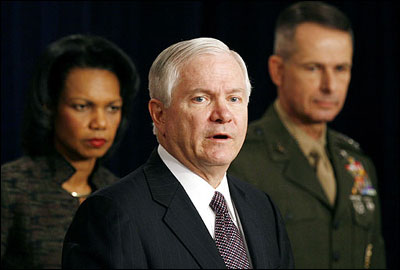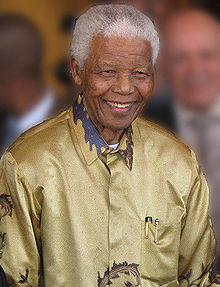Raw Story: US has been covertly arming Gulf States since 2004, officials say
Yesterday, Secretary of State Condoleezza Rice and Secretary of Defense Robert Gates made a rare joint visit to Saudi Arabia to meet with members of the monarchy, as well as representatives of other Gulf States including the United Arab Emirates, to discuss a $20 billion dollar arms deal to deliver weapons, training, and weapons systems upgrades to Saudi Arabia over the next ten years. Although officially the meeting is to negotiate an agreement, sources have confirmed to RAW STORY that the deal has already been approved.
Arming the Gulf states
According to current and former intelligence officials, however, the Bush administration has been arming Gulf Cooperation Council (GCC) states covertly since “at least” 2004, a year after the US-led invasion of Iraq in March of 2003.

Secretary of State Condoleezza Rice and Secretary of Defense Robert Gates made a rare joint visit to Saudi Arabia
The GCC is a union of regional allies, including Saudi Arabia, Bahrain, Kuwait, Oman, Qatar and the United Arab Emirates. Created in 1981, it is similar in structure and purpose to the European Union.
Using backchannels and corporate partners, arms have been furnished to the Gulf states to beef up security against what the US sees as an increased risk posed by Iran. Along with sharing various resources, GCC members have agreed to jointly combine military forces.
According to the NSC official, the current Saudi deal serves two purposes, both of which are a direct result of the US-led war against Iraq and the regional instability it has caused. One is to support the Saudi rulers, while the other is to isolate Iran.
The most pressing concern for the Saudi royal family is their ability to maintain power. The Saudi royal family, who are Sunnis, see the election of Shi’a Muslim Nouri al-Maliki as Iraqi Prime Minister as a signal that the Shi’a state of Iran could become more powerful and threaten the sovereignty of the House of Saud. Beyond that, the royals also fear that their own people might overthrow the monarchy should instability in the region continue to worsen.
“The Saudis see Maliki as the cat’s paw of Iran and they think we are actively supporting Maliki,” the NSC official said. “What the monarchy is actively worried about is that guys who got bloodied in Iraq will return home and overthrow them, and that would be very bad for us.”
Not everyone agrees.
In an email to RAW STORY Wednesday, Lawrence Wilkerson, former chief of staff to Secretary of State Colin Powell, said he believes the deal is unwise.
“I believe that the $20B arms package just announced – and the diplomacy accompanying it – is a complete refutation of the Bush/Rice policy of refusing to coddle the autocracies of the Middle East,” Wilkerson said. “Because we are afraid of Tehran, we are willing to fund massively regimes whose interests are not only counter to our own but who are actively engaged in covertly undermining U.S. interests, from supporting anti-U.S. elements in Iraq to building and funding thousands of madrassas in volatile places like the Federally Administered Territories in Pakistan.”
Bribing the House of Saud?
Several military and intelligence sources say that the other major impetus behind the arms deal is the Bush administration’s focus on destabilizing and isolating Iran. Part of that strategy involves cutting Iran off from dealing with companies that also have business dealing with Saudi Arabia and, at the same time, protecting Saudi Arabia from any fallout over US activities against Iran. According to the Washington Post, separate arms deals have also been approved for both Israel and Egypt to “strengthen pro-Western countries against Iran at a time when the hard-line regime seeks to extend its power in the region.”
Another motivation for the arms deal is the Bush administration’s need for support to curb the democratically elected Maliki’s influence while at the same time demonstrating “good faith” to the Saudis, who have increasingly become disillusioned with US policy in Iraq and mishandling of the Iraq war.
“There is a real fear that the [Saudi monarchy] will move towards France and Britain,” said the NSC official. A military official pointed out that with the increase in Asian demand for Saudi Arabia’s largest export, oil, the Arab nation now has more leeway to break away from its long-standing relationship with the United States.
Wilkerson points out, however, that the deal prioritizes aid to just three countries.
Deal with Northrop Grunmman alleged
A former high level State Department official pointed to at least one company that is providing weapons to the Saudi National Guard: Northrop Grunmman subsidiary Vinnell Corporation.
“The Vinnell Corp has been in that business for decades,” said this official.
The defense giant Northrop Grunmman was in talks with the Saudis in March of this year to sell them their E-2D Hawkeye 2000, a form of early air warning system.
Vinnell is also the quasi-official security training firm for the Saudis, through a joint Saudi-US enterprise called Vinnell Arabia.
Yet another offshoot of Northrop is Vinnell-Brown & Root, which is a joint venture between Northrop Grunmman and Halliburton, the controversial company of which Vice President Cheney was the CEO until the 2000 election.
Vinnell-Brown & Root is also involved in training the Saudi National Guard.
One source familiar with the backchannel sales of weapons to the GCC states said there is a connection between the leadership of the 3rd Infantry Division of the US Army, from Fort Stewart Georgia, and Vinnell Corporation, but would not elaborate.
In April 2006, Robert Joseph, undersecretary of state for arms control and international security, visited the GCC states in an attempt to broker a deal to install a missile defense system aimed against Iran.
While the arms list for the current deal is still shrouded in secrecy, if former deals are any indication, the Saudis will receive high caliber weapons that are top-of the line “system deployed with U.S. forces,” including M-1A2 Abrams main battle tanks, M-2A2 Bradley armored vehicles, F-15E Strike Eagle attack aircraft and Patriot surface-to-air missiles.
Saudis worry about Iraq fighters coming back
The greatest number of foreign fighters in Iraq are Saudi Arabs, making up roughly 45 percent of all foreign militants. Though not allied with any specific terrorist group, some Saudis are loosely affiliated with Al Qaeda; most, however, are simply fighting the Shi’a government of Iraq, which they perceive as a threat, as well as the US-led coalition, which they see as an even greater concern.
The result of this influx of foreign fighters and pervasive anti-Western sentiments has been a catastrophic radicalization of Muslims in general and Saudi Arabs in particular.
Such fighters, notes the former NSC official, have been radicalized and trained on the streets of Anbar province, and those who might return home to overthrow the Saudi monarchy will be that much more capable.
sfux - 3. Aug, 20:25 Article 3232x read
















































